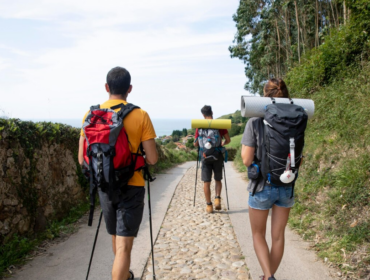Are you seriously going to trade the great outdoors for months of indoor hibernation? Winter hiking is all about reaping the benefits that make staying indoors feel like a bad joke. Sure, there are myriad benefits of winter hiking; the only question is, where do you wish to start? Here’s the thing: you’ll feel chilly when you start. That’s a given. But once you get moving, your body warms up, and the fear of frostbite fades like yesterday’s snowstorm.
By the time you find your rhythm, you’ll wonder why you waited so long to try it. Suddenly, they stood in a world of towering, snow-laden trees and pristine, untouched snow. Anxieties melted away, replaced by awe and the rare joy of being fully present. That’s only psychological benefits, and just the start!
Introduction
Winter hiking has its rules, though. Take breaks—three to five minutes is plenty. Proper clothing transforms a freezing trek into something surprisingly comfortable. There’s no bad weather, only bad clothes—warm snacks, hand warmers, extra layers, hot tea, and gear designed to tackle 20-degree mornings on a mountainside.
There’s something deeper about winter hiking, too. If trauma lives in our bodies, then healing must involve movement, even when the air bites with cold. Snow-covered trails offer more than beauty; they’re easier on the knees and kinder to your joints. The chill clears your mind, sharpening focus and calming the spirit.
Winter hiking challenges us in ways summer hikes never do. It demands a different mindset, but it offers the chance to reconnect with the living world around us. It’s part of our ancient heritage.
Winter gets a bad rap. It’s tempting to see it as a season of stillness, an enemy to enjoyment. But stepping into the cold, even for a short adventure, can change everything.
Nature teaches reciprocity with every step we take. What you give to the wild, it gives back in kind. This balance—the Andean concept of ayni—is echoed in cultures around the world. Filipinos call it bayanihan, the spirit of communal unity. The Cherokee have gadugi, working together for the greater good. It’s a reminder: to truly receive, you must first show up, ready to give.
1 – Building Muscle
You might roll your eyes, but hiking could outshine dieting, running, or even lifting weights—if done right.
Every step you take sends a ripple of effort through your body. It’s a symphony of muscles working together in a natural, effective workout. Your quadriceps? They’re the unsung heroes, tackling every incline, carrying you forward like loyal warriors. And don’t forget your abs and lats as they’re pulling their weight too, especially when you’re hauling that packed backpack.
Rocks, slopes, tangled roots—they keep your hamstrings on their toes. Ever notice how hikers have calves that look like they moonlight as marble statues? That’s the terrain talking. No treadmill could replicate this.
Sure, your arms and abs don’t steal the show, but they’re in the background, carrying the load, literally. The gear you lug determines their workout, turning every hike into a customizable fitness challenge.
2 – Rediscovering Nature’s Magic

Tech screens and busy schedules have robbed us of the simple joys, like pausing to admire a blooming flower or breathing in crisp, unpolluted air.
Most of us live in cities where the air feels more like soup than oxygen. Forests, though? They’re a reminder that lungs were meant to inhale purity. But there’s more to hiking than just fresh air.
When you walk through the wild, something clicks. You’re no longer just a cog in the machine; you’re part of something bigger. The peace you feel? It’s not just a mood boost—it’s your mind thanking you for the quiet moments to think, to reset, to just be. And when you return to daily life, you carry that calm with you, like a souvenir.
3 – Hiking Meets Camping
There’s something magical about a campsite coming to life: the crackle of a fire, the sizzle of food. But while you wait for dinner, why not wander a bit? The woods are full of stories waiting to be discovered.
Of course, safety first. Forests can be as unpredictable as they are beautiful. A good pocket knife? That’s not just gear—it’s your best friend. Cutting rope, slicing food, or dealing with a prickly situation (literally)—a knife does it all.
Before you set off:
- Know your route. How far? How steep? How remote? Don’t just wing it.
- Check the weather forecast, including wind chill. At higher altitudes, weather can turn on a dime.
- Verify emergency cell coverage along the trail. No coverage? Double-check your contingency plans.
- Share your plans. Leave your route and expected return time with someone who isn’t hiking with you. Sign the trailhead register—it’s a lifeline for park rangers in emergencies.
Being prepared is the golden rule. Many a trip has soured because campers underestimated the wild. But the beauty of hiking is how seamlessly it prepares you for camping. The gear overlaps, the skills translate, and the budget breathes a sigh of relief.
What to Wear for Winter Hikes
Winter conditions demand thoughtful layering to combat frostbite or hypothermia. This is where style bows to survival.
- Layer up: Several thin layers beat one bulky jacket. Start with a wicking base layer to keep sweat away from your skin, add insulating layers, and finish with a wind- and water-resistant outer shell.
- Cover extremities: A wool hat, thick gloves or mittens, and two pairs of socks are non-negotiable. And those boots? Waterproof with solid grip soles.
- Don’t forget sunscreen: Snow reflects sunlight, making sunburn a sneaky winter threat.
Carry Essentials to Stay Safe
Your pack is more than a convenience—it’s your survival kit.
- Extra food and water: Winter hikes burn more calories than summer ones. Pack nutrient-dense snacks like trail mix or granola bars. Bring a thermos of something warm to stave off chills.
- First aid kit: Include bandages for slips or scrapes and a heat-reflecting blanket for hypothermia. Hypothermia can strike even in above-freezing temps. Watch for shivering, confusion, exhaustion, or slurred words. If these signs appear, act quickly.
- Light source: Plan to finish your hike well before dark, but bring a flashlight or headlamp just in case.
- Navigation tools: A phone, map, compass, or GPS device (and extra batteries) are essentials. But don’t rely solely on your phone.
Winter hiking can be a transformative experience if done safely. The cold may be unforgiving, but with the right preparation, it becomes a doorway to wonder and connection. Bundle up, plan ahead, and embrace the chill—it just might warm your spirit.
The Bottom Line
Why fight winter? The cold is here to stay. Layer up. Fill a thermos with hot chocolate. Let yourself befriend the stillness of the season. Reflect. Slow down. And if you can, gather a few friends for a winter hike. Make a promise to change your relationship with the cold. Give yourself permission to experience the peace, intention, and quiet joy that come with being outside. You might just find that winter’s not an enemy—it’s a gift. Happy wintering.





